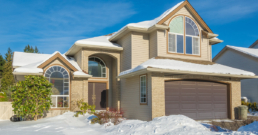
As extreme weather poses a threat to the safety of your home, it’s important to prepare for harsh conditions. Prioritizing winter home safety can go a long way in preventing an insurance claim during the colder months. At Doeren Mayhew Insurance, we understand how safeguarding your home against common winter storm damage — and related slips and falls — can help protect your family’s financial health.
It’s simply not enough to secure adequate homeowners insurance to cover any potential insurance claims. From frozen pipes and chimney fires to liability claims after someone falls on your property, these common insurance claims in the winter can largely be avoided. Read on to learn about what your homeowners insurance covers, and how you can prevent accidents and reduce homeowner costs.
What Does Homeowners Insurance Cover in Winter?
Standard home insurance covers most types of winter damage associated with snow, rain, wind, and ice. Examples include frozen pipes, collapsed roofs, or window damage caused by extreme weather events. However, there are other types of winter storm repairs and replacements that will not be covered, including those caused by flood damage and preventable damage.
The latter refers to pipes, HVAC systems, windows, doors, and other parts of your house that were not reasonably sealed or repaired ahead of the winter storms. That’s why it’s imperative to heed winter safety tips to provide optimal protection against costly insurance claims.
Winter Home Safety Tips
- Set your thermostat to a fixed temperature: This tip not only helps prevent freeze pipes, but it is also an energy-efficient practice that helps save up to 10% on your home’s annual heating bill. The U.S. Department of Energy recommends setting your thermostat to 68°F while the World Health Organization advises a slightly lower safe indoor temperature of 64°F.
- Insulate, insulate, insulate: Don’t let winter wreak havoc on your home this season by protecting everything from water pipes, vents, doors, and windows, to ceilings, outdoor faucets, and the attic. By insulating these areas that are vulnerable to cracks, leaks, and structural damage, you can lower your energy bills and hedge against costly insurance damage — and related claims.
- Protect trees and shrubs: Shield both the trees and shrubs from the harsh winter climate — and your physical home — by pruning about 10-15% of the foliage around your house. This helps keep them healthy, provide clearance for safely walking around your property, and it reduces the threat of becoming a safety hazard. Tree limbs should always stay away from power lines and your home’s windows and doors.
- Sweep, shovel, and salt: Keep your pathways clear of ice and debris to maintain a safe environment for all family members, visitors, and passersby. There are many products designed for residential applications that will help pre-treat your sidewalk and driveway ahead of a winter storm — and de-ice steps and walkways after the weather hits. Be sure to select non-abrasive and non-toxic materials that keep pets and other visitors safe and healthy.
As the temperatures plummet and harsh conditions become more commonplace, homeowners must think about safety to prevent accidents, damage, and costly insurance claims. At Doeren Mayhew Insurance, we provide the time-tested guidance our clients rely on to safeguard their long-term resilience and financial health in the face of winter safety concerns. Contact us to speak to a trusted insurance agent today.